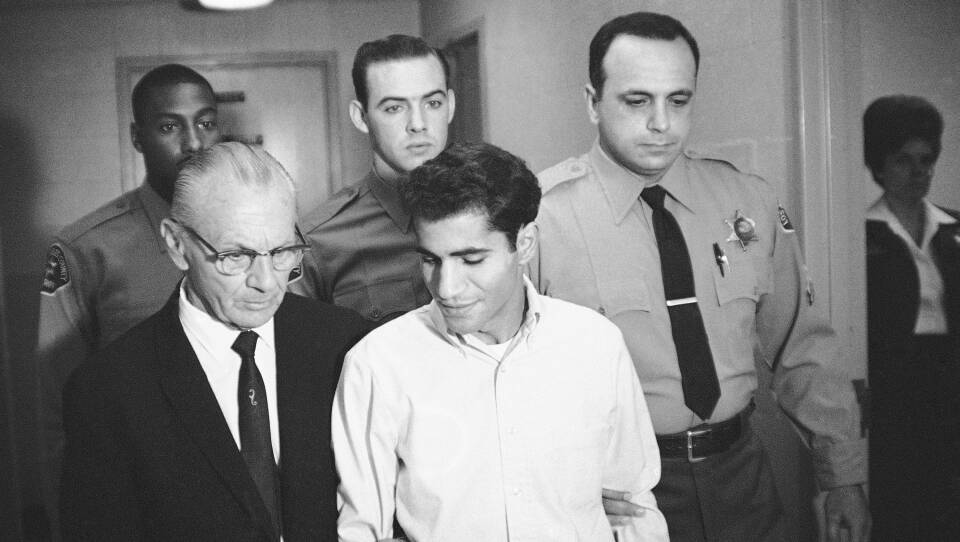Sirhan Sirhan, the man who assassinated Robert F. Kennedy, was deemed “suitable for parole” last Friday by a California parole panel after more than 50 years in prison. Joseph Kennedy II, the oldest son of RFK, is condemning the decision. In a letter he says: "there are differing views about ending the sentence of this killer, including within my own family. But emotions and opinions do not change facts or history." Daniel Medwed, Northeastern University law professor and GBH News legal analyst, joined Aaron Schachter on Morning Edition to discuss what does come into play when a decision like this is make. This transcript has been edited for clarity.
Schachter: Daniel, let’s set the table here. This was Sirhan Sirhan's 16th attempt at being paroled. How does the process typically operate in the U.S.?
Medwed: It varies from state to state, but the general idea is this: Parole is a way to reward model prisoners for good behavior by granting them conditional release into the free world where they will continue to be monitored by law enforcement until the end of their sentence. It evolved in the nineteenth century, first in Europe, then here, at a time when the rehabilitative model of criminal justice was in vogue, the idea that people can change, and change for the better, and that there should be incentives for prisoners to do so.
In deciding whether a prisoner is worthy of parole, boards often consider a wide range of variables — the prisoner’s criminal history, behavior while incarcerated, psychological makeup and preparedness for the outside world — with the aim of releasing only those who’ve made strides toward self-improvement and no longer pose a safety threat.
Schachter: So what does this decision in California exactly mean? Is Sirhan Sirhan on the brink of being released?
Medwed: No, we’re a long way off from that. This was just a recommendation from a two-person panel, and there are several additional hurdles for him to overcome. First, according to California procedure, parole staff have 90 days to review that matter and the full parole board essentially has a say.
Second, even if they agree with the recommendation, the governor has the final word. And apparently, in an odd twist, Governor Gavin Newsom worships RFK; his office is even full of photos of mourners from RFK’s funeral train. He’s also shown a willingness to reject parole board recommendations in controversial cases, for instance, he refused to release a prominent follower of Charles Manson late last year. That said, Newsom is mired in a bitter recall election and it’s unclear who will be at the helm in Sacramento when this lands there.
WATCH: Daniel Medwed on subjectivity of parole decisions
Schachter: Daniel, RFK’s remaining family was deeply divided and many members were firmly opposed to parole. Shouldn’t the views of the victim’s family be taken into consideration?
Medwed: Yes, victim impact statements are part of the equation and strong opposition by many of RFK’s relatives may eventually lead to a reversal of this recommendation. But the views of victims are just a piece of a parole decision-making process that is much more art than science.
In Sirhan Sirhan’s case, here are some other factors that aided his case: he’s spent more than 50 years in prison; he’s owned up to the murder, albeit under the influence of alcohol; he evidently hasn’t been accused of a serious disciplinary infraction in prison since 1972; and now, at age 77, he’s unlikely to pose a public safety threat. I’m not saying he deserves release, just that those factors probably influenced the panel.
Schachter: So the parole process is pretty subjective, more art than science. Isn’t that a problem? It could be recipe for bias to flourish.
Medwed: That’s absolutely right. I recall a study of the New Jersey parole system from the 1970s that labeled the average parole recipient “white and contrite.” Bias definitely has a way of infiltrating the process and that’s why in recent years there’s a movement to reform the parole process through the use of algorithms — assigning “points” for certain categories, like criminal history, and effectively have a computer generate the release decision.
On the one hand, this could remove some of the subjectivity from the equation. On the other hand, algorithms are only as good as their inputs. And since so many of criminal justice system’s inputs, like arrest rates, are plagued by racial biases in policing and prosecuting, it’s hard to say these so-called objective risk assessment tools are much better. As one scholar, professor Sandra Mayson has put it, “Bias in, Bias out.”
Schachter: Well, you’ve made a complicated legal issue a lot easier to understand. Thank you, Daniel.







